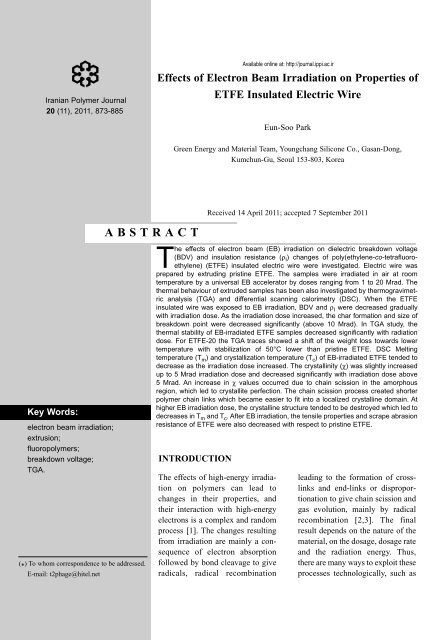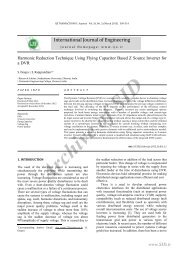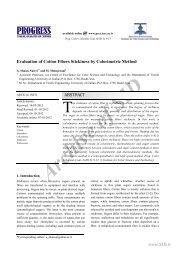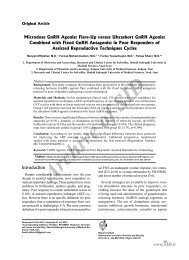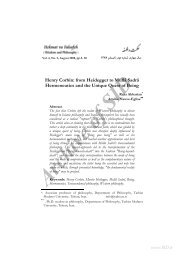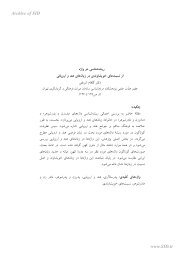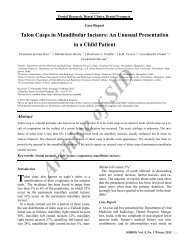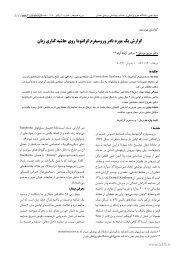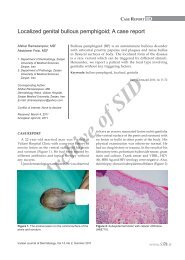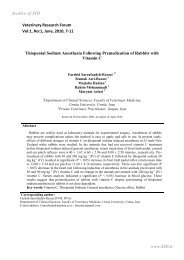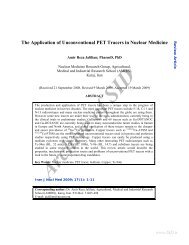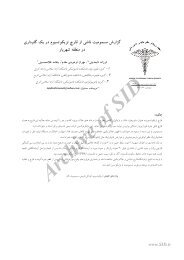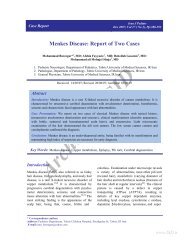effects of electron beam irradiation on properties of etfe insulated ...
effects of electron beam irradiation on properties of etfe insulated ...
effects of electron beam irradiation on properties of etfe insulated ...
Create successful ePaper yourself
Turn your PDF publications into a flip-book with our unique Google optimized e-Paper software.
Iranian Polymer Journal<br />
20 (11), 2011, 873-885<br />
Key Words:<br />
<str<strong>on</strong>g>electr<strong>on</strong></str<strong>on</strong>g> <str<strong>on</strong>g>beam</str<strong>on</strong>g> <str<strong>on</strong>g>irradiati<strong>on</strong></str<strong>on</strong>g>;<br />
extrusi<strong>on</strong>;<br />
fluoropolymers;<br />
breakdown voltage;<br />
TGA.<br />
( * ) To whom corresp<strong>on</strong>dence to be addressed.<br />
E-mail: t2phage@hitel.net<br />
ABSTRACT<br />
Effects <str<strong>on</strong>g>of</str<strong>on</strong>g> Electr<strong>on</strong> Beam Irradiati<strong>on</strong> <strong>on</strong> Properties <str<strong>on</strong>g>of</str<strong>on</strong>g><br />
ETFE Insulated Electric Wire<br />
Eun-Soo Park<br />
Green Energy and Material Team, Youngchang Silic<strong>on</strong>e Co., Gasan-D<strong>on</strong>g,<br />
Kumchun-Gu, Seoul 153-803, Korea<br />
Received 14 April 2011; accepted 7 September 2011<br />
The <str<strong>on</strong>g>effects</str<strong>on</strong>g> <str<strong>on</strong>g>of</str<strong>on</strong>g> <str<strong>on</strong>g>electr<strong>on</strong></str<strong>on</strong>g> <str<strong>on</strong>g>beam</str<strong>on</strong>g> (EB) <str<strong>on</strong>g>irradiati<strong>on</strong></str<strong>on</strong>g> <strong>on</strong> dielectric breakdown voltage<br />
(BDV) and insulati<strong>on</strong> resistance (ρ I ) changes <str<strong>on</strong>g>of</str<strong>on</strong>g> poly(ethylene-co-tetrafluoroethylene)<br />
(ETFE) <strong>insulated</strong> electric wire were investigated. Electric wire was<br />
prepared by extruding pristine ETFE. The samples were irradiated in air at room<br />
temperature by a universal EB accelerator by doses ranging from 1 to 20 Mrad. The<br />
thermal behaviour <str<strong>on</strong>g>of</str<strong>on</strong>g> extruded samples has been also investigated by thermogravimetric<br />
analysis (TGA) and differential scanning calorimetry (DSC). When the ETFE<br />
<strong>insulated</strong> wire was exposed to EB <str<strong>on</strong>g>irradiati<strong>on</strong></str<strong>on</strong>g>, BDV and ρ I were decreased gradually<br />
with <str<strong>on</strong>g>irradiati<strong>on</strong></str<strong>on</strong>g> dose. As the <str<strong>on</strong>g>irradiati<strong>on</strong></str<strong>on</strong>g> dose increased, the char formati<strong>on</strong> and size <str<strong>on</strong>g>of</str<strong>on</strong>g><br />
breakdown point were decreased significantly (above 10 Mrad). In TGA study, the<br />
thermal stability <str<strong>on</strong>g>of</str<strong>on</strong>g> EB-irradiated ETFE samples decreased significantly with radiati<strong>on</strong><br />
dose. For ETFE-20 the TGA traces showed a shift <str<strong>on</strong>g>of</str<strong>on</strong>g> the weight loss towards lower<br />
temperature with stabilizati<strong>on</strong> <str<strong>on</strong>g>of</str<strong>on</strong>g> 50°C lower than pristine ETFE. DSC Melting<br />
temperature (T m ) and crystallizati<strong>on</strong> temperature (T c ) <str<strong>on</strong>g>of</str<strong>on</strong>g> EB-irradiated ETFE tended to<br />
decrease as the <str<strong>on</strong>g>irradiati<strong>on</strong></str<strong>on</strong>g> dose increased. The crystallinity (χ) was slightly increased<br />
up to 5 Mrad <str<strong>on</strong>g>irradiati<strong>on</strong></str<strong>on</strong>g> dose and decreased significantly with <str<strong>on</strong>g>irradiati<strong>on</strong></str<strong>on</strong>g> dose above<br />
5 Mrad. An increase in χ values occurred due to chain scissi<strong>on</strong> in the amorphous<br />
regi<strong>on</strong>, which led to crystallite perfecti<strong>on</strong>. The chain scissi<strong>on</strong> process created shorter<br />
polymer chain links which became easier to fit into a localized crystalline domain. At<br />
higher EB <str<strong>on</strong>g>irradiati<strong>on</strong></str<strong>on</strong>g> dose, the crystalline structure tended to be destroyed which led to<br />
decreases in T m and T c . After EB <str<strong>on</strong>g>irradiati<strong>on</strong></str<strong>on</strong>g>, the tensile <strong>properties</strong> and scrape abrasi<strong>on</strong><br />
resistance <str<strong>on</strong>g>of</str<strong>on</strong>g> ETFE were also decreased with respect to pristine ETFE.<br />
INTRODUCTION<br />
The <str<strong>on</strong>g>effects</str<strong>on</strong>g> <str<strong>on</strong>g>of</str<strong>on</strong>g> high-energy <str<strong>on</strong>g>irradiati<strong>on</strong></str<strong>on</strong>g><br />
<strong>on</strong> polymers can lead to<br />
changes in their <strong>properties</strong>, and<br />
their interacti<strong>on</strong> with high-energy<br />
<str<strong>on</strong>g>electr<strong>on</strong></str<strong>on</strong>g>s is a complex and random<br />
process [1]. The changes resulting<br />
from <str<strong>on</strong>g>irradiati<strong>on</strong></str<strong>on</strong>g> are mainly a c<strong>on</strong>sequence<br />
<str<strong>on</strong>g>of</str<strong>on</strong>g> <str<strong>on</strong>g>electr<strong>on</strong></str<strong>on</strong>g> absorpti<strong>on</strong><br />
followed by b<strong>on</strong>d cleavage to give<br />
radicals, radical recombinati<strong>on</strong><br />
Available <strong>on</strong>line at: http://journal.ippi.ac.ir<br />
leading to the formati<strong>on</strong> <str<strong>on</strong>g>of</str<strong>on</strong>g> crosslinks<br />
and end-links or disproporti<strong>on</strong>ati<strong>on</strong><br />
to give chain scissi<strong>on</strong> and<br />
gas evoluti<strong>on</strong>, mainly by radical<br />
recombinati<strong>on</strong> [2,3]. The final<br />
result depends <strong>on</strong> the nature <str<strong>on</strong>g>of</str<strong>on</strong>g> the<br />
material, <strong>on</strong> the dosage, dosage rate<br />
and the radiati<strong>on</strong> energy. Thus,<br />
there are many ways to exploit these<br />
processes technologically, such as
Effects <str<strong>on</strong>g>of</str<strong>on</strong>g> Electr<strong>on</strong> Beam Irradiati<strong>on</strong> <strong>on</strong> Properties ... Park E-S<br />
cross-linking [4-7] and surface modificati<strong>on</strong> [8-10].<br />
Poly(ethylene-co-tetrafluoroethylene) (ETFE)<br />
copolymers occupy a special positi<strong>on</strong> am<strong>on</strong>g fluoropolymers<br />
as they are c<strong>on</strong>tain alternating structural<br />
units <str<strong>on</strong>g>of</str<strong>on</strong>g> polyethylene and poly(tetrafluoroethylene)<br />
which are c<strong>on</strong>ferred with a unique combinati<strong>on</strong> <str<strong>on</strong>g>of</str<strong>on</strong>g><br />
<strong>properties</strong> imparted from both hydrocarb<strong>on</strong> and fluorocarb<strong>on</strong><br />
polymers [5]. They are comm<strong>on</strong>ly used in<br />
nuclear industry for tie or cable wraps, and in the aviati<strong>on</strong><br />
industry as coating materials. Another key use<br />
<str<strong>on</strong>g>of</str<strong>on</strong>g> ETFE is for the covering <str<strong>on</strong>g>of</str<strong>on</strong>g> electrical wiring used<br />
in high stress, low fume toxicity and high reliability<br />
applicati<strong>on</strong>s. ETFE is frequently used as wire<br />
insulati<strong>on</strong> either in its natural state [11] or crosslinked<br />
for improved physical <strong>properties</strong> [12-15].<br />
Electr<strong>on</strong> <str<strong>on</strong>g>beam</str<strong>on</strong>g> (EB) cross-linked ETFE wire is widely<br />
used in aircraft airframes. Electrically <strong>insulated</strong><br />
wires are <str<strong>on</strong>g>of</str<strong>on</strong>g>ten used in envir<strong>on</strong>ments in which the<br />
physical, mechanical, electrical and thermal <strong>properties</strong><br />
<str<strong>on</strong>g>of</str<strong>on</strong>g> the insulati<strong>on</strong> are put to test by extreme<br />
c<strong>on</strong>diti<strong>on</strong>s. The ETFE insulati<strong>on</strong> is thinner and lighter<br />
than the materials used for comparable wires. It can<br />
be used at temperatures up to 200°C and will<br />
withstand temperature as low as -65°C [14]. This is<br />
because ETFE copolymers have excellent mechanical<br />
toughness, chemical resistance and electrical <strong>properties</strong><br />
[10]. In additi<strong>on</strong>, ETFE exhibits a high-energy<br />
radiati<strong>on</strong> resistance and can withstand moderately<br />
high temperatures for a l<strong>on</strong>g period <str<strong>on</strong>g>of</str<strong>on</strong>g> time.<br />
Wolf et al. have studied the thermal oxidative<br />
degradati<strong>on</strong> <str<strong>on</strong>g>of</str<strong>on</strong>g> a semi-crystalline thermoplastic polymer<br />
and ETFE used for electrical insulati<strong>on</strong> as a<br />
functi<strong>on</strong> <str<strong>on</strong>g>of</str<strong>on</strong>g> <str<strong>on</strong>g>irradiati<strong>on</strong></str<strong>on</strong>g>, temperature and its c<strong>on</strong>tact<br />
with a metal surface [16]. They found that the rate <str<strong>on</strong>g>of</str<strong>on</strong>g><br />
thermal degradati<strong>on</strong> is a str<strong>on</strong>g functi<strong>on</strong> <str<strong>on</strong>g>of</str<strong>on</strong>g> the total<br />
radiati<strong>on</strong> dose regardless <str<strong>on</strong>g>of</str<strong>on</strong>g> its c<strong>on</strong>ductor element. A<br />
spectroscopic evaluati<strong>on</strong> <str<strong>on</strong>g>of</str<strong>on</strong>g> a commercial wire<br />
insulati<strong>on</strong> based <strong>on</strong> a cross-linked ETFE was also<br />
c<strong>on</strong>ducted by Morelli et al. to determine the chemical<br />
changes taking place during thermal aging. These<br />
studies have provided insight into the roles <str<strong>on</strong>g>of</str<strong>on</strong>g> the<br />
Table 1. ETFE Specificati<strong>on</strong>s.<br />
874<br />
Iranian Polymer Journal / Volume 20 Number 11 (2011)<br />
various additives, such as triallylisocyanurate and<br />
antim<strong>on</strong>y oxide, in the formulated cross-linked ETFE<br />
insulati<strong>on</strong> [17]. However, research works <strong>on</strong> the<br />
effect <str<strong>on</strong>g>of</str<strong>on</strong>g> <str<strong>on</strong>g>electr<strong>on</strong></str<strong>on</strong>g>-<str<strong>on</strong>g>beam</str<strong>on</strong>g> <str<strong>on</strong>g>irradiati<strong>on</strong></str<strong>on</strong>g> <strong>on</strong> ETFE <strong>insulated</strong><br />
wire and its c<strong>on</strong>sequent radiati<strong>on</strong> induced changes <strong>on</strong><br />
the insulati<strong>on</strong> <strong>properties</strong> are scarce despite their<br />
extensive use [11-17]. As in the case <str<strong>on</strong>g>of</str<strong>on</strong>g> many other<br />
polymeric materials, i<strong>on</strong>izing radiati<strong>on</strong> has various<br />
<str<strong>on</strong>g>effects</str<strong>on</strong>g> <strong>on</strong> fluoropolymers and fluorinated polymers<br />
[3-6]. The absorbed dose distributi<strong>on</strong> depends <strong>on</strong> the<br />
thickness, density and atomic compositi<strong>on</strong> <str<strong>on</strong>g>of</str<strong>on</strong>g> the<br />
insulati<strong>on</strong> as well as the diameter and compositi<strong>on</strong> <str<strong>on</strong>g>of</str<strong>on</strong>g><br />
the metallic c<strong>on</strong>ductor. Because <str<strong>on</strong>g>of</str<strong>on</strong>g> the cylindrical<br />
geometry and the shielding and backscattering <str<strong>on</strong>g>effects</str<strong>on</strong>g><br />
<str<strong>on</strong>g>of</str<strong>on</strong>g> the c<strong>on</strong>ductor, accurate calculati<strong>on</strong>s <str<strong>on</strong>g>of</str<strong>on</strong>g> the dose<br />
distributi<strong>on</strong> are not simple [15]. In this study, the<br />
<str<strong>on</strong>g>effects</str<strong>on</strong>g> <str<strong>on</strong>g>of</str<strong>on</strong>g> <str<strong>on</strong>g>electr<strong>on</strong></str<strong>on</strong>g> <str<strong>on</strong>g>beam</str<strong>on</strong>g> (EB) <str<strong>on</strong>g>irradiati<strong>on</strong></str<strong>on</strong>g> <strong>on</strong> ETFE<br />
<strong>insulated</strong> electric wire were studied. Insulati<strong>on</strong>s are<br />
comm<strong>on</strong>ly used as a flexible polymer coating <strong>on</strong><br />
electric wire. The service life <str<strong>on</strong>g>of</str<strong>on</strong>g> an electric wire is<br />
determined by the c<strong>on</strong>diti<strong>on</strong> <str<strong>on</strong>g>of</str<strong>on</strong>g> the insulating<br />
material [18,19]. An electric wire was prepared by<br />
extruding pristine ETFE and EB-irradiated at doses<br />
ranging from 1 to 20 Mrad. The microstructure,<br />
electrical, mechanical and thermal <strong>properties</strong> <str<strong>on</strong>g>of</str<strong>on</strong>g> EBirradiated<br />
wire were evaluated.<br />
EXPERIMENTAL<br />
Materials<br />
ETFE resin (Ne<str<strong>on</strong>g>of</str<strong>on</strong>g>l<strong>on</strong> EP512, Daikin Industries,<br />
Tokyo, Japan) was used as received. The resin was<br />
pre-dried in a c<strong>on</strong>vecti<strong>on</strong> oven for at least 12 h at<br />
100°C to remove any moisture from the pellets before<br />
processing. The characteristics <str<strong>on</strong>g>of</str<strong>on</strong>g> the resin used in<br />
this study are summarized in Table 1.<br />
Extrusi<strong>on</strong> <str<strong>on</strong>g>of</str<strong>on</strong>g> Electric Wire<br />
The electric wire was composed <str<strong>on</strong>g>of</str<strong>on</strong>g> a c<strong>on</strong>ductor and<br />
Material Density (g/cm3 ) Hardness (Shore D) Tm (°C ) Melt flow index<br />
(g/10 min)<br />
ETFE 1.74 75 261 12 (372°C/49 N load)
Park E-S<br />
an insulati<strong>on</strong> layer. The insulati<strong>on</strong> layer was applied<br />
to the annealed copper c<strong>on</strong>ductor by extrusi<strong>on</strong> with<br />
ETFE resin (thickness: 1 mm). ETFE pellets were<br />
dried in a hopper equipped with a dehumidifying<br />
dryer at least 24 h at 100°C to remove any moisture<br />
from the pellets before extruding. The wire sample<br />
was extruded (temperature setting <str<strong>on</strong>g>of</str<strong>on</strong>g> rear z<strong>on</strong>e:<br />
280°C, sec<strong>on</strong>d z<strong>on</strong>e: 295°C, forward z<strong>on</strong>e: 305°C,<br />
adapter: 320°C and die: 340°C) at a speed <str<strong>on</strong>g>of</str<strong>on</strong>g><br />
200 rpm using a single screw extruder (TE4001, D<strong>on</strong>g<br />
Bang Engineering, Ansan, Korea) equipped with 40<br />
mm <str<strong>on</strong>g>of</str<strong>on</strong>g> diameter screw. Extruded samples were<br />
quenched by passage through a water-cooling z<strong>on</strong>e at<br />
a rate <str<strong>on</strong>g>of</str<strong>on</strong>g> 50 m/min.<br />
Electr<strong>on</strong> Beam Irradiati<strong>on</strong> <str<strong>on</strong>g>of</str<strong>on</strong>g> Electric Wire<br />
Electr<strong>on</strong> <str<strong>on</strong>g>beam</str<strong>on</strong>g> <str<strong>on</strong>g>irradiati<strong>on</strong></str<strong>on</strong>g> <str<strong>on</strong>g>of</str<strong>on</strong>g> extruded wire was<br />
carried out using an EB accelerator (ELV 4, EB Tech<br />
Co., Daeje<strong>on</strong>, Korea). The samples were placed <strong>on</strong> a<br />
tray <str<strong>on</strong>g>of</str<strong>on</strong>g> a c<strong>on</strong>veyer and irradiated in air at room<br />
temperature. The c<strong>on</strong>veyer speed was kept c<strong>on</strong>stant at<br />
1 m/min. The applied <str<strong>on</strong>g>irradiati<strong>on</strong></str<strong>on</strong>g> dose was varied<br />
from 1 to 20 Mrad by increasing the number <str<strong>on</strong>g>of</str<strong>on</strong>g><br />
passes. The doses were verified using cellulose triacetate<br />
(CTA) dosimeter film based <strong>on</strong> ISO/<br />
ASTM51650 [20]. The specificati<strong>on</strong>s <str<strong>on</strong>g>of</str<strong>on</strong>g> the ELV-4<br />
are presented in Table 2.<br />
Characterizati<strong>on</strong><br />
Insulati<strong>on</strong> resistance (ρ I ) <str<strong>on</strong>g>of</str<strong>on</strong>g> samples was measured by<br />
a megohmmeter (TeraOhm 5kV, Metrel, USA)<br />
according to ASTM D 257 [21]. The charge time was<br />
30 s, and the current stress <str<strong>on</strong>g>of</str<strong>on</strong>g> the measurements was<br />
500 V at 20°C ± 1°C.<br />
Scanning <str<strong>on</strong>g>electr<strong>on</strong></str<strong>on</strong>g> microscopy (SEM) observati<strong>on</strong>s<br />
<str<strong>on</strong>g>of</str<strong>on</strong>g> the samples were performed <strong>on</strong> a Hitachi<br />
S-4300 model (Tokyo, Japan). The fractured surfaces<br />
<str<strong>on</strong>g>of</str<strong>on</strong>g> the composites were prepared by using cryogenic<br />
fracturing in liquid nitrogen followed by a coating<br />
with platinum in an SPI sputter coater. The<br />
Table 2. Specificati<strong>on</strong>s <str<strong>on</strong>g>of</str<strong>on</strong>g> the ELV-4 EB accelerator.<br />
Effects <str<strong>on</strong>g>of</str<strong>on</strong>g> Electr<strong>on</strong> Beam Irradiati<strong>on</strong> <strong>on</strong> Properties ...<br />
morphology was determined using an accelerating<br />
voltage <str<strong>on</strong>g>of</str<strong>on</strong>g> 15 kV.<br />
The Fourier transform infrared (FTIR) absorpti<strong>on</strong><br />
spectra <str<strong>on</strong>g>of</str<strong>on</strong>g> the EB-irradiated samples were measured<br />
with a Perkin Elmer infrared spectrometer (Spectrum<br />
2000, Shelt<strong>on</strong>, CT) in KBr pellets. The spectra<br />
were measured in the wavenumber range from 4000<br />
to 400 cm -1 and analyzed using a commercial s<str<strong>on</strong>g>of</str<strong>on</strong>g>tware.<br />
The surface appearance <str<strong>on</strong>g>of</str<strong>on</strong>g> samples was measured<br />
with a video microscope (Inf-500TM, charge-coupled<br />
device (CCD) video microscope, Moritex Corp.,<br />
Tokyo, Japan) with a PC that c<strong>on</strong>tained video capture<br />
s<str<strong>on</strong>g>of</str<strong>on</strong>g>tware (i-Soluti<strong>on</strong> Lite, Image & Microscope<br />
Technology, Daeje<strong>on</strong>, Korea).<br />
Thermal <strong>properties</strong> <str<strong>on</strong>g>of</str<strong>on</strong>g> the specimen were determined<br />
by DSC (differential scanning calorimetry)<br />
(Perkin Elmer DSC 7, Norwalk, CT). The thermal<br />
history <str<strong>on</strong>g>of</str<strong>on</strong>g> the samples was removed by scanning to<br />
300°C with the heating rate <str<strong>on</strong>g>of</str<strong>on</strong>g> 20°C/min. After<br />
cooling down the specimen to room temperature at<br />
the rate <str<strong>on</strong>g>of</str<strong>on</strong>g> -5°C/min, it was re-heated at 20°C to<br />
300°C with the heating rate <str<strong>on</strong>g>of</str<strong>on</strong>g> 20°C/min and the DSC<br />
curves were obtained. The heat <str<strong>on</strong>g>of</str<strong>on</strong>g> melting and the<br />
heat <str<strong>on</strong>g>of</str<strong>on</strong>g> crystallizati<strong>on</strong> were calculated from the areas<br />
under the melting and cooling peaks, respectively.<br />
The degree <str<strong>on</strong>g>of</str<strong>on</strong>g> crystallinity (χ) was calculated using<br />
the following equati<strong>on</strong> [5]:<br />
(%) ( / 100 ) 100 × Δ Δ = m m H H χ<br />
(1)<br />
where, ΔH m is the heat <str<strong>on</strong>g>of</str<strong>on</strong>g> melting <str<strong>on</strong>g>of</str<strong>on</strong>g> ETFE films and<br />
it is proporti<strong>on</strong>al to the area under the melting peak<br />
and ΔH m100 is the heat <str<strong>on</strong>g>of</str<strong>on</strong>g> melting <str<strong>on</strong>g>of</str<strong>on</strong>g> 100%<br />
crystalline ETFE polymer, which equals 113.4 J/g [4].<br />
Thermal stability <str<strong>on</strong>g>of</str<strong>on</strong>g> samples was determined by<br />
thermogravimetry (TGA Q50, TA instrument, USA).<br />
The TG curves were obtained under N 2 atmosphere at<br />
a flow rate <str<strong>on</strong>g>of</str<strong>on</strong>g> 4 mL/min and a scanning from 20°C to<br />
800°C with the heating rate <str<strong>on</strong>g>of</str<strong>on</strong>g> 20°C/min.<br />
Energy (MeV) EB power (kW) N<strong>on</strong>-uniformity <str<strong>on</strong>g>of</str<strong>on</strong>g> current density (%) Input voltage (V)<br />
0.8~1.5 50 < 10 220/380<br />
Iranian Polymer Journal / Volume 20 Number 11 (2011)<br />
875
Effects <str<strong>on</strong>g>of</str<strong>on</strong>g> Electr<strong>on</strong> Beam Irradiati<strong>on</strong> <strong>on</strong> Properties ... Park E-S<br />
Tensile Test Procedure<br />
Tube type specimens for mechanical tests were<br />
prepared in accordance with IEC 60811-1-1 [22]<br />
specificati<strong>on</strong>. The sample <str<strong>on</strong>g>of</str<strong>on</strong>g> wire was cut into pieces<br />
approximately 100 mm l<strong>on</strong>g and the c<strong>on</strong>ductor was<br />
removed by careful rolling <str<strong>on</strong>g>of</str<strong>on</strong>g> the wire under low<br />
mechanical force. The test specimens were prec<strong>on</strong>diti<strong>on</strong>ed<br />
to 20% relative humidity and 20 ± 1°C in<br />
order to standardize test c<strong>on</strong>diti<strong>on</strong>s. Tensile <strong>properties</strong><br />
<str<strong>on</strong>g>of</str<strong>on</strong>g> the samples were determined with a universal<br />
test machine (UTM, Model DECMC00, Dawha<br />
Test Machine, Korea) at a cross-head speed <str<strong>on</strong>g>of</str<strong>on</strong>g><br />
250 mm/min. The mean value <str<strong>on</strong>g>of</str<strong>on</strong>g> at least five<br />
specimens <str<strong>on</strong>g>of</str<strong>on</strong>g> each sample was taken, although the<br />
specimens that broke in an unusual manner were<br />
disregarded.<br />
Scrape Abrasi<strong>on</strong> Resistance Test<br />
Scrape abrasi<strong>on</strong> resistance was measured using an<br />
Abrasi<strong>on</strong> Tester (Core Tech, Korea). The test pieces<br />
were 750 mm <str<strong>on</strong>g>of</str<strong>on</strong>g> extruded wire in length and they<br />
were prepared by EB <str<strong>on</strong>g>irradiati<strong>on</strong></str<strong>on</strong>g>. The travel distance<br />
<str<strong>on</strong>g>of</str<strong>on</strong>g> specimen was 10 mm at a speed <str<strong>on</strong>g>of</str<strong>on</strong>g> 60 cycles per<br />
minute and the test loads were 5 N and 10 N. The<br />
abrasive used was a needle (material: tungsten<br />
carbide, diameter: 4.5 mm, knife: 4.5 mm × 1 mm).<br />
Each specimen underwent five tests and was moved<br />
about 100 mm between each test and turned at an<br />
angle <str<strong>on</strong>g>of</str<strong>on</strong>g> 90°, always in the same directi<strong>on</strong>. A wire<br />
sample was fixed to the sample holder and 24 V<br />
direct current (DC) voltage was applied between<br />
abrasive and wire c<strong>on</strong>ductor. When electric c<strong>on</strong>tact<br />
occurred between abrasive and c<strong>on</strong>ductor, test<br />
equipment stopped running and the cycles at breakdown<br />
were automatically counted.<br />
ETFE<br />
ETFE-01<br />
ETFE-05<br />
ETFE-10<br />
ETFE-15<br />
ETFE-20<br />
876<br />
Sample<br />
code<br />
No crack<br />
No crack<br />
No crack<br />
No crack<br />
No crack<br />
No crack<br />
Iranian Polymer Journal / Volume 20 Number 11 (2011)<br />
Flexibility Test<br />
A straight piece <str<strong>on</strong>g>of</str<strong>on</strong>g> 300 mm wire was carefully wound<br />
in 10 c<strong>on</strong>tinuous adjacent turns around a polished<br />
mandrel <str<strong>on</strong>g>of</str<strong>on</strong>g> 60 mm diameter. The specimen was<br />
placed into an oven with forced air circulati<strong>on</strong> at<br />
room temperature or 240°C for 30 min. After removal<br />
from the oven, the specimen was allowed to cool to<br />
room temperature. After cooling the thermally aged<br />
wire was straightened and was examined for cracks<br />
under a video microscope.<br />
Breakdown Voltage Measurement<br />
The measurements <str<strong>on</strong>g>of</str<strong>on</strong>g> breakdown voltage (BDV)<br />
were carried out at 60 Hz alternating current (AC)<br />
voltage by using a high voltage tester (SM-40PT08,<br />
Sungmin Instruments, Korea) with a rate <str<strong>on</strong>g>of</str<strong>on</strong>g> 0.5 kV/s<br />
in air. The test sample c<strong>on</strong>sisted <str<strong>on</strong>g>of</str<strong>on</strong>g> copper c<strong>on</strong>ductor<br />
(diameter <str<strong>on</strong>g>of</str<strong>on</strong>g> 2 mm) and outer insulator (insulati<strong>on</strong><br />
thickness <str<strong>on</strong>g>of</str<strong>on</strong>g> 1 mm). Before c<strong>on</strong>ducting the BDV test,<br />
an aluminium foil was wrapped around the outer<br />
surface <str<strong>on</strong>g>of</str<strong>on</strong>g> the wire. An AC voltage was applied<br />
between the aluminium wrap and the wire c<strong>on</strong>ductor<br />
and a dielectric BDV was measured. Ten samples<br />
were tested and the average voltage was calculated.<br />
RESULTS AND DISCUSSION<br />
Table 3. Insulati<strong>on</strong> <strong>properties</strong> <str<strong>on</strong>g>of</str<strong>on</strong>g> the EB-irradiated wire before and after flexibility test.<br />
BDV and ρ I Changes <str<strong>on</strong>g>of</str<strong>on</strong>g> Extruded Wire after EB<br />
Irradiati<strong>on</strong><br />
The ETFE <strong>insulated</strong> wire was subjected to EB <str<strong>on</strong>g>irradiati<strong>on</strong></str<strong>on</strong>g><br />
(1 to 20 Mrad) and the BDV measurement<br />
results <str<strong>on</strong>g>of</str<strong>on</strong>g> the EB-irradiated samples are summarized<br />
in Table 3 (left part). The abbreviati<strong>on</strong> <str<strong>on</strong>g>of</str<strong>on</strong>g> the sample<br />
code in Table 3, ETFE-01, for example, means that<br />
EB <str<strong>on</strong>g>irradiati<strong>on</strong></str<strong>on</strong>g> Thermal aging at 240°C for 30 min<br />
Flexibility BDV (kV) Flexibility BDV (kV)<br />
21.6 ± 0.6<br />
21.3 ± 0.6<br />
20.9 ± 1.1<br />
20.5 ± 1.4<br />
18.7 ± 0.5<br />
16.8 ± 1.9<br />
No crack<br />
No crack<br />
No crack<br />
No crack<br />
No crack<br />
No crack<br />
21.5 ± 1.3<br />
18.8 ± 2.6<br />
17.8 ± 0.8<br />
16.8 ± 5.0<br />
16.3 ± 5.6<br />
14.0 ± 3.1
Park E-S<br />
the ETFE <strong>insulated</strong> wire was EB-irradiated at<br />
1 Mrad. The BDV <str<strong>on</strong>g>of</str<strong>on</strong>g> ETFE-01, ETFE-05 and ETFE-<br />
10 were slightly changed compared with pristine<br />
ETFE. In sharp c<strong>on</strong>trast BDV <str<strong>on</strong>g>of</str<strong>on</strong>g> ETFE-15 and ETFE-<br />
20 were decreased significantly. Approximately 13%<br />
and 22% decreases were observed in BDV <str<strong>on</strong>g>of</str<strong>on</strong>g> 18.7 and<br />
16.8 kV, respectively. The dielectric breakdown causes<br />
a high-temperature arc to propagate through a<br />
Effects <str<strong>on</strong>g>of</str<strong>on</strong>g> Electr<strong>on</strong> Beam Irradiati<strong>on</strong> <strong>on</strong> Properties ...<br />
(a) (d)<br />
(b) (e)<br />
(c) (f)<br />
Figure 1. Images <str<strong>on</strong>g>of</str<strong>on</strong>g> the breakdown points after dielectric breakdown test (200x).<br />
dielectric medium and these can lead to igniti<strong>on</strong> <str<strong>on</strong>g>of</str<strong>on</strong>g> the<br />
medium or <str<strong>on</strong>g>of</str<strong>on</strong>g> the surrounding objects. Figure 1<br />
dem<strong>on</strong>strates the breakdown points after dielectric<br />
breakdown test. As the <str<strong>on</strong>g>irradiati<strong>on</strong></str<strong>on</strong>g> dose increased, the<br />
char formati<strong>on</strong> and size <str<strong>on</strong>g>of</str<strong>on</strong>g> breakdown point were<br />
decreased significantly (above 10 Mrad). This means<br />
that the breakdown <str<strong>on</strong>g>of</str<strong>on</strong>g> EB-irradiated wire is determined<br />
by the electrical field at the tip <str<strong>on</strong>g>of</str<strong>on</strong>g> the defect.<br />
Iranian Polymer Journal / Volume 20 Number 11 (2011) 877
Effects <str<strong>on</strong>g>of</str<strong>on</strong>g> Electr<strong>on</strong> Beam Irradiati<strong>on</strong> <strong>on</strong> Properties ... Park E-S<br />
Figure 2. Insulati<strong>on</strong> resistance (ρ I ) changes after EB<br />
<str<strong>on</strong>g>irradiati<strong>on</strong></str<strong>on</strong>g>.<br />
878 Iranian Polymer Journal / Volume 20 Number 11 (2011)<br />
After EB <str<strong>on</strong>g>irradiati<strong>on</strong></str<strong>on</strong>g>, the changing ρ I <str<strong>on</strong>g>of</str<strong>on</strong>g> wire samples<br />
also shows the same behaviour (Figure 2). ρ I is the<br />
resistance to current leakage through and over the surface<br />
<str<strong>on</strong>g>of</str<strong>on</strong>g> the material. It is found that by measuring the<br />
direct current or voltage drop across an electrical<br />
insulating material its resistance may be determined<br />
by the applicati<strong>on</strong> <str<strong>on</strong>g>of</str<strong>on</strong>g> Ohm's law and it is typically<br />
expressed in MΩ. The microstructural defects such as<br />
voids, cracks, delaminati<strong>on</strong>s and impurities are<br />
associated with variati<strong>on</strong>s <str<strong>on</strong>g>of</str<strong>on</strong>g> ρ I .<br />
Figure 3 represents SEM micrographs <str<strong>on</strong>g>of</str<strong>on</strong>g> the<br />
fractured surface <str<strong>on</strong>g>of</str<strong>on</strong>g> the extruded ETFE insulati<strong>on</strong><br />
before and after EB <str<strong>on</strong>g>irradiati<strong>on</strong></str<strong>on</strong>g>. The pristine ETFE<br />
shows a single phase with clear brittle fracture<br />
behaviour. After <str<strong>on</strong>g>irradiati<strong>on</strong></str<strong>on</strong>g> at 5 Mrad, the fractured<br />
surface did not show any morphological change<br />
(a) (c)<br />
(b) (d)<br />
Figure 3. SEM Micrographs <str<strong>on</strong>g>of</str<strong>on</strong>g> the fractured surface <str<strong>on</strong>g>of</str<strong>on</strong>g> the extruded ETFE insulati<strong>on</strong> before and after EB <str<strong>on</strong>g>irradiati<strong>on</strong></str<strong>on</strong>g>.
Park E-S<br />
CH 2<br />
CH 2<br />
CH 2<br />
CH 2<br />
CH CH 2<br />
H + F<br />
EB <str<strong>on</strong>g>irradiati<strong>on</strong></str<strong>on</strong>g><br />
CF 2<br />
CF 2<br />
CF 2<br />
Chain scissi<strong>on</strong><br />
CF 2<br />
CF 2<br />
compared with pristine ETFE. In the micrographs<br />
taken <strong>on</strong> the surface <str<strong>on</strong>g>of</str<strong>on</strong>g> 15 and 20 Mrad irradiated<br />
specimens, the wave texture was disappeared and<br />
many voids were found.<br />
As shown in Scheme I, the radiati<strong>on</strong> induced<br />
chemical changes in polymers including chain crosslinking,<br />
chain scissi<strong>on</strong> and creati<strong>on</strong> <str<strong>on</strong>g>of</str<strong>on</strong>g> small<br />
molecular products, structural and morphological<br />
changes [5,9]. When voids are present in solid<br />
dielectrics and the electrical field is sufficiently high,<br />
the air or other gases inside the voids i<strong>on</strong>izes and<br />
creates breakdown pulses across the voids. These<br />
pulses are referred to as discharges. Most soliddielectric<br />
insulati<strong>on</strong>s degrade under the presence <str<strong>on</strong>g>of</str<strong>on</strong>g><br />
partial discharge and lead to premature failure <str<strong>on</strong>g>of</str<strong>on</strong>g> the<br />
insulati<strong>on</strong>. These discharges result in an increase in<br />
current flow through the insulati<strong>on</strong> between the<br />
c<strong>on</strong>ductor and ground and a c<strong>on</strong>sequent reducti<strong>on</strong> in<br />
the amount <str<strong>on</strong>g>of</str<strong>on</strong>g> current which is able to be transmitted<br />
through the c<strong>on</strong>ductor. This failing process increases<br />
the dielectric absorpti<strong>on</strong> current taken by the<br />
insulati<strong>on</strong>, and megohmmeter shows a decrease in ρ I<br />
with increasing voids in insulati<strong>on</strong> by EB <str<strong>on</strong>g>irradiati<strong>on</strong></str<strong>on</strong>g>.<br />
Thermal Stability <str<strong>on</strong>g>of</str<strong>on</strong>g> ETFE Insulated Wire after<br />
EB Irradiati<strong>on</strong><br />
Table 3 (2 columns in the right) shows the result <str<strong>on</strong>g>of</str<strong>on</strong>g><br />
flexibility test and dielectric BDV <str<strong>on</strong>g>of</str<strong>on</strong>g> EB-irradiated<br />
wires after thermal aging at 240°C for 30 min. After<br />
CF<br />
Dehydr<str<strong>on</strong>g>of</str<strong>on</strong>g>luorinati<strong>on</strong><br />
Formati<strong>on</strong> <str<strong>on</strong>g>of</str<strong>on</strong>g> unsaturated b<strong>on</strong>ds<br />
Effects <str<strong>on</strong>g>of</str<strong>on</strong>g> Electr<strong>on</strong> Beam Irradiati<strong>on</strong> <strong>on</strong> Properties ...<br />
CH 2<br />
CH 2<br />
CH 2<br />
CH 2<br />
CH 2<br />
flexibility test at 240°C for 30 min, extruded- and<br />
EB-irradiated wire did not show insulati<strong>on</strong> crack<br />
phenomen<strong>on</strong>. The BDV <str<strong>on</strong>g>of</str<strong>on</strong>g> pristine ETFE was not<br />
significantly changed after thermal aging. In general,<br />
c<strong>on</strong>tinuous maximum temperature rating <str<strong>on</strong>g>of</str<strong>on</strong>g> ETFE<br />
<strong>insulated</strong> wire is 155°C. It withstands temperature up<br />
to 180°C for 168 c<strong>on</strong>tinuous hours [23] and it goes<br />
under thermal aging at 240°C with no cracks<br />
detected after exposure for 30 min [24]. In sharp<br />
c<strong>on</strong>trast, when the EB-irradiated wire has been<br />
exposed to thermal aging at 240°C for 30 min, the<br />
BDV reducti<strong>on</strong> is more significant (Table 3). The<br />
BDV reducti<strong>on</strong>s are 12.6, 17.2, 21.9, 24.2 and 34.9%<br />
as in the order given for ETFE-01, ETFE-05,<br />
ETFE-10, ETFE-15 and ETFE-20 with respect to that<br />
<str<strong>on</strong>g>of</str<strong>on</strong>g> corresp<strong>on</strong>ding un-irradiated thermally aged<br />
sample. The thermal aging is manifested in two ways<br />
<str<strong>on</strong>g>of</str<strong>on</strong>g> forming polymer radicals [25] and microvoids [26]<br />
in the material. This leads to formati<strong>on</strong> <str<strong>on</strong>g>of</str<strong>on</strong>g> defects <str<strong>on</strong>g>of</str<strong>on</strong>g><br />
extruded layer and lowering the BDV <str<strong>on</strong>g>of</str<strong>on</strong>g> wire samples<br />
significantly [19].<br />
Figure 4 dem<strong>on</strong>strates the surface images <str<strong>on</strong>g>of</str<strong>on</strong>g> EBirradiated<br />
wire before and after thermal aging at<br />
240°C for 30 min. The surface <str<strong>on</strong>g>of</str<strong>on</strong>g> the EB-irradiated<br />
samples shows increased scratching with the<br />
<str<strong>on</strong>g>irradiati<strong>on</strong></str<strong>on</strong>g> dose. In sharp c<strong>on</strong>trast, after thermal aging<br />
<str<strong>on</strong>g>of</str<strong>on</strong>g> the EB-irradiated samples the number and the size<br />
<str<strong>on</strong>g>of</str<strong>on</strong>g> the black spots <strong>on</strong> the surface <str<strong>on</strong>g>of</str<strong>on</strong>g> insulati<strong>on</strong> were<br />
increased as the <str<strong>on</strong>g>irradiati<strong>on</strong></str<strong>on</strong>g> dose increased. The<br />
Iranian Polymer Journal / Volume 20 Number 11 (2011) 879<br />
CH<br />
CH 2<br />
CH<br />
CF 2<br />
C<br />
F<br />
CF 2<br />
CF CF 2<br />
CF 2<br />
CF 2<br />
Cross-linking<br />
Scheme I. Schematic representati<strong>on</strong> <str<strong>on</strong>g>of</str<strong>on</strong>g> mechanism <str<strong>on</strong>g>of</str<strong>on</strong>g> EB <str<strong>on</strong>g>irradiati<strong>on</strong></str<strong>on</strong>g> induced reacti<strong>on</strong>s in ETFE.<br />
CF 2<br />
+ H<br />
+ F
Effects <str<strong>on</strong>g>of</str<strong>on</strong>g> Electr<strong>on</strong> Beam Irradiati<strong>on</strong> <strong>on</strong> Properties ... Park E-S<br />
(a) (b) (c)<br />
(d) (e) (f)<br />
accelerated aging at higher temperature is caused by<br />
an increasing thermal degradati<strong>on</strong> <str<strong>on</strong>g>of</str<strong>on</strong>g> an organic<br />
material. Structural changes in ETFE that accompany<br />
the formati<strong>on</strong> <str<strong>on</strong>g>of</str<strong>on</strong>g> surface defects by the EB <str<strong>on</strong>g>irradiati<strong>on</strong></str<strong>on</strong>g><br />
can cause significant reducti<strong>on</strong> in thermal oxidati<strong>on</strong><br />
resistance <str<strong>on</strong>g>of</str<strong>on</strong>g> insulati<strong>on</strong>.<br />
TGA Measurements were also c<strong>on</strong>ducted <strong>on</strong><br />
EB-irradiated samples to elucidate their thermal<br />
degradati<strong>on</strong> behaviours. Some typical weight-loss<br />
curves as a functi<strong>on</strong> <str<strong>on</strong>g>of</str<strong>on</strong>g> temperature are shown in<br />
Figure 5. The weight loss <str<strong>on</strong>g>of</str<strong>on</strong>g> fluoropolymers is<br />
associated with evoluti<strong>on</strong> <str<strong>on</strong>g>of</str<strong>on</strong>g> small molecules initially<br />
(g) (h)<br />
Figure 4. Images <str<strong>on</strong>g>of</str<strong>on</strong>g> EB-irradiated wire before and after thermal aging at 240°C for 30 min (300x).<br />
880 Iranian Polymer Journal / Volume 20 Number 11 (2011)<br />
beginning with water and then low molecular weight<br />
oligomers and finally HF. It is observed that the<br />
partially fluorinated ETFE is stable up to 450°C and<br />
shows <strong>on</strong>e step <str<strong>on</strong>g>of</str<strong>on</strong>g> weight loss. In c<strong>on</strong>trast, the thermal<br />
stability <str<strong>on</strong>g>of</str<strong>on</strong>g> EB-irradiated ETFE samples decreases<br />
significantly with increasing radiati<strong>on</strong> dose. For<br />
ETFE-20 the TGA traces show a significant shift <str<strong>on</strong>g>of</str<strong>on</strong>g><br />
the weight loss towards lower temperature with stabilizati<strong>on</strong><br />
<str<strong>on</strong>g>of</str<strong>on</strong>g> 50°C lower than pristine ETFE. As listed in<br />
Table 4, it can be seen that the pristine ETFE exhibits<br />
a higher thermal-oxidative stability in terms <str<strong>on</strong>g>of</str<strong>on</strong>g> T -5%<br />
(a mass loss <str<strong>on</strong>g>of</str<strong>on</strong>g> 5% occurs during degradati<strong>on</strong>) with
Figure 5. TGA Thermograms <str<strong>on</strong>g>of</str<strong>on</strong>g> the EB-irradiated ETFE<br />
samples.<br />
Park E-S<br />
respect to that <str<strong>on</strong>g>of</str<strong>on</strong>g> EB-irradiated samples. Meanwhile,<br />
the residues at 500°C are 84.9, 82.6, 63.7, 57.3, 54.6<br />
and 49.5% for ETFE, ETFE-01, ETFE-05, ETFE-10,<br />
ETFE-15, and ETFE-20, for the above given order,<br />
which c<strong>on</strong>firms that the EB <str<strong>on</strong>g>irradiati<strong>on</strong></str<strong>on</strong>g> facilitates thermal<br />
degradati<strong>on</strong>. These findings are in good agreement<br />
with the result <str<strong>on</strong>g>of</str<strong>on</strong>g> the BDV reducti<strong>on</strong> listed in<br />
Table 3.<br />
After thermal aging, it is also found that the<br />
copper c<strong>on</strong>ductor <str<strong>on</strong>g>of</str<strong>on</strong>g> EB-irradiated wire changed into<br />
yellowish colour (Figure 6). This suggested that EB<br />
<str<strong>on</strong>g>irradiati<strong>on</strong></str<strong>on</strong>g> could promote dehydrogenati<strong>on</strong> <str<strong>on</strong>g>of</str<strong>on</strong>g> ETFE<br />
at a lower temperature compared to pristine ETFE.<br />
Copper oxidizes slowly in air, corroding to produce a<br />
brown or green patina. At higher temperatures the<br />
process is much faster and produces mainly black<br />
copper oxide (Figure 6a). The oxide can be reduced<br />
by hydrogen gas (H 2 ), which is a moderately str<strong>on</strong>g<br />
reducing agent, producing a shiny, clean copper<br />
surface.<br />
Equati<strong>on</strong>s for the reacti<strong>on</strong>s are:<br />
2Cu ( s)<br />
+ 1/<br />
2O2(<br />
g)<br />
→ 2CuO<br />
( s)<br />
CuO ( s)<br />
+<br />
H 2(<br />
g)<br />
→ Cu ( s)<br />
+ H 2O<br />
( g)<br />
(2)<br />
(3)<br />
Figure 7 shows FTIR spectra <str<strong>on</strong>g>of</str<strong>on</strong>g> pristine and EBirradiated<br />
ETFE samples. After EB <str<strong>on</strong>g>irradiati<strong>on</strong></str<strong>on</strong>g>, small<br />
adjacent bands at 1741 and 1654 cm -1 can be<br />
Effects <str<strong>on</strong>g>of</str<strong>on</strong>g> Electr<strong>on</strong> Beam Irradiati<strong>on</strong> <strong>on</strong> Properties ...<br />
Table 4. TGA data for the EB-irradiated ETFE insulati<strong>on</strong>.<br />
Sample<br />
code<br />
ETFE<br />
ETFE-01<br />
ETFE-05<br />
ETFE-10<br />
ETFE-15<br />
ETFE-20<br />
identified and their amplitudes increase with<br />
increasing <str<strong>on</strong>g>irradiati<strong>on</strong></str<strong>on</strong>g> dose. These two bands are<br />
assigned for -C=O and -C=C- groups, respectively<br />
[5]. Moreover, the intensity <str<strong>on</strong>g>of</str<strong>on</strong>g> the band at 2985 cm -1<br />
decreases with increasing <str<strong>on</strong>g>irradiati<strong>on</strong></str<strong>on</strong>g> dose, which<br />
could be an indicati<strong>on</strong> <str<strong>on</strong>g>of</str<strong>on</strong>g> cleavage <str<strong>on</strong>g>of</str<strong>on</strong>g> C-H b<strong>on</strong>ds.<br />
Mechanical and Thermal Properties Changes after<br />
EB Irradiati<strong>on</strong><br />
Table 5 summarizes the effect <str<strong>on</strong>g>of</str<strong>on</strong>g> EB <str<strong>on</strong>g>irradiati<strong>on</strong></str<strong>on</strong>g> <strong>on</strong> the<br />
tensile <strong>properties</strong> <str<strong>on</strong>g>of</str<strong>on</strong>g> ETFE copolymer. It is noteworthy<br />
that tensile strength <str<strong>on</strong>g>of</str<strong>on</strong>g> EB-irradiated samples was<br />
slightly decreased up<strong>on</strong> <str<strong>on</strong>g>irradiati<strong>on</strong></str<strong>on</strong>g>. In sharp c<strong>on</strong>trast,<br />
the el<strong>on</strong>gati<strong>on</strong>-at-break <str<strong>on</strong>g>of</str<strong>on</strong>g> EB-irradiated samples was<br />
decreased gradually with <str<strong>on</strong>g>irradiati<strong>on</strong></str<strong>on</strong>g> dose. In case <str<strong>on</strong>g>of</str<strong>on</strong>g><br />
ETFE20, an approximately 57% decrease in the<br />
el<strong>on</strong>gati<strong>on</strong>-at-break <str<strong>on</strong>g>of</str<strong>on</strong>g> 210% was observed relative to<br />
that <str<strong>on</strong>g>of</str<strong>on</strong>g> pristine ETFE. The decreased tensile <strong>properties</strong><br />
<str<strong>on</strong>g>of</str<strong>on</strong>g> the EB-irradiated samples might be explained<br />
by the scissi<strong>on</strong> <str<strong>on</strong>g>of</str<strong>on</strong>g> macromolecular chains induced by<br />
EB <str<strong>on</strong>g>irradiati<strong>on</strong></str<strong>on</strong>g> [3]. It can be also found that there is a<br />
Table 5. Tensile <strong>properties</strong> <str<strong>on</strong>g>of</str<strong>on</strong>g> EB-irradiated ETFE<br />
specimens.<br />
Sample<br />
code<br />
ETFE<br />
ETFE-01<br />
ETFE-05<br />
ETFE-10<br />
ETFE-15<br />
ETFE-20<br />
T -5%<br />
(°C)<br />
480.7<br />
477.4<br />
455.4<br />
449.4<br />
446.8<br />
441.1<br />
Tensile strength<br />
(MPa)<br />
38.2 ± 0.7<br />
36.1 ± 3.4<br />
36.4 ± 0.5<br />
36.8 ± 0.6<br />
37.2 ± 0.4<br />
36.9 ± 0.6<br />
Tensile <strong>properties</strong><br />
Residues at 500°C<br />
(%)<br />
84.9<br />
82.6<br />
63.7<br />
57.3<br />
54.6<br />
49.5<br />
El<strong>on</strong>gati<strong>on</strong>-at-break<br />
Iranian Polymer Journal / Volume 20 Number 11 (2011) 881<br />
(%)<br />
484 ± 46<br />
441 ± 32<br />
307 ± 30<br />
283 ± 42<br />
220 ± 67<br />
210 ± 71
Effects <str<strong>on</strong>g>of</str<strong>on</strong>g> Electr<strong>on</strong> Beam Irradiati<strong>on</strong> <strong>on</strong> Properties ... Park E-S<br />
(a) (e)<br />
(b) (f)<br />
(c) (g)<br />
(d) (h)<br />
Figure 6. Surface images <str<strong>on</strong>g>of</str<strong>on</strong>g> EB-irradiated c<strong>on</strong>ductor samples before and after thermal aging at 240°C for 30 min (300x).<br />
882 Iranian Polymer Journal / Volume 20 Number 11 (2011)
Park E-S<br />
Figure 7. FTIR Spectra <str<strong>on</strong>g>of</str<strong>on</strong>g> the EB-irradiated ETFE.<br />
decreasing trend in scrape abrasi<strong>on</strong> resistance with<br />
increase in <str<strong>on</strong>g>irradiati<strong>on</strong></str<strong>on</strong>g> dose compared to un-irradiated<br />
wire (Figure 8). As scrape abrasi<strong>on</strong> resistance<br />
basically depends <strong>on</strong> the hardness <str<strong>on</strong>g>of</str<strong>on</strong>g> a material, this<br />
may indicate that EB <str<strong>on</strong>g>irradiati<strong>on</strong></str<strong>on</strong>g> also results in reducti<strong>on</strong><br />
<str<strong>on</strong>g>of</str<strong>on</strong>g> surface hardness.<br />
The results <str<strong>on</strong>g>of</str<strong>on</strong>g> DSC thermal <strong>properties</strong> <str<strong>on</strong>g>of</str<strong>on</strong>g> EBirradiated<br />
samples are summarized in Table 6.<br />
Melting temperature (T m ) and crystallizati<strong>on</strong> temperature<br />
(T c ) <str<strong>on</strong>g>of</str<strong>on</strong>g> EB-irradiated ETFE tend to decrease as<br />
the <str<strong>on</strong>g>irradiati<strong>on</strong></str<strong>on</strong>g> dose increases. In general, it is accepted<br />
that the effect <str<strong>on</strong>g>of</str<strong>on</strong>g> <str<strong>on</strong>g>irradiati<strong>on</strong></str<strong>on</strong>g>, either <str<strong>on</strong>g>electr<strong>on</strong></str<strong>on</strong>g> <str<strong>on</strong>g>beam</str<strong>on</strong>g><br />
or gamma rays, <strong>on</strong> the crystalline regi<strong>on</strong> causes some<br />
imperfecti<strong>on</strong>s. Meanwhile, χ was slightly increased<br />
up to 5 Mrad and decreased significantly with<br />
Table 6. DSC thermal <strong>properties</strong> <str<strong>on</strong>g>of</str<strong>on</strong>g> EB-irradiated ETFE sample.<br />
Sample<br />
code<br />
ETFE<br />
ETFE-01<br />
ETFE-05<br />
ETFE-10<br />
ETFE-15<br />
ETFE-20<br />
T m1<br />
(°C)<br />
263.2<br />
263.0<br />
260.3<br />
259.4<br />
258.4<br />
252.3<br />
Effects <str<strong>on</strong>g>of</str<strong>on</strong>g> Electr<strong>on</strong> Beam Irradiati<strong>on</strong> <strong>on</strong> Properties ...<br />
Figure 8. Scrape abrasi<strong>on</strong> resistance test results <str<strong>on</strong>g>of</str<strong>on</strong>g> EBirradiated<br />
wire.<br />
<str<strong>on</strong>g>irradiati<strong>on</strong></str<strong>on</strong>g> dose above 5 Mrad. The polymer melting<br />
behaviour and crystallinity were influenced by<br />
radiati<strong>on</strong> processing [4, 5]. An increase in χ values<br />
occurs due to chain scissi<strong>on</strong> in the amorphous regi<strong>on</strong>,<br />
which leads to crystallite perfecti<strong>on</strong>. The chain<br />
scissi<strong>on</strong> process creates shorter polymer chain links<br />
which become easier to fit into a localized crystalline<br />
domain. At higher EB <str<strong>on</strong>g>irradiati<strong>on</strong></str<strong>on</strong>g> dose, the crystalline<br />
structure tends to be destroyed which leads to<br />
decreases in T m and T c .<br />
CONCLUSION<br />
Pristine ETFE resin was extruded as an electric wire<br />
DSC thermal <strong>properties</strong><br />
First-scan Sec<strong>on</strong>d-scan Crystallizati<strong>on</strong><br />
ΔH m1<br />
(J/g)<br />
32.2<br />
33.1<br />
32.6<br />
31.6<br />
24.6<br />
13.9<br />
T m2<br />
(°C)<br />
261.1<br />
260.9<br />
256.6<br />
252.8<br />
250.6<br />
250.2<br />
ΔH m2<br />
(J/g)<br />
33.1<br />
34.7<br />
35.9<br />
29.1<br />
20.2<br />
16.5<br />
T c<br />
(°C)<br />
33.1<br />
34.7<br />
35.9<br />
29.1<br />
20.2<br />
16.5<br />
-ΔH c<br />
(J/g)<br />
-32.5<br />
-33.2<br />
-38.6<br />
-37.2<br />
-36.6<br />
-33.9<br />
χ<br />
(%)<br />
29.2<br />
30.6<br />
31.7<br />
25.7<br />
17.8<br />
14.6<br />
Iranian Polymer Journal / Volume 20 Number 11 (2011) 883
Effects <str<strong>on</strong>g>of</str<strong>on</strong>g> Electr<strong>on</strong> Beam Irradiati<strong>on</strong> <strong>on</strong> Properties ... Park E-S<br />
and the EB <str<strong>on</strong>g>irradiati<strong>on</strong></str<strong>on</strong>g> <str<strong>on</strong>g>effects</str<strong>on</strong>g> <strong>on</strong> the microstructure,<br />
electrical, mechanical and thermal <strong>properties</strong> <str<strong>on</strong>g>of</str<strong>on</strong>g><br />
extruded wire were investigated. When the ETFE<br />
<strong>insulated</strong> wire was exposed to EB <str<strong>on</strong>g>irradiati<strong>on</strong></str<strong>on</strong>g>, BDV<br />
and ρ I were decreased gradually with increased EB<br />
<str<strong>on</strong>g>irradiati<strong>on</strong></str<strong>on</strong>g> dose. This was due to EB <str<strong>on</strong>g>irradiati<strong>on</strong></str<strong>on</strong>g><br />
induced chemical changes in polymers creating weak<br />
pathways and they reduced ρ I and accelerated<br />
dielectric breakdown. SEM Observati<strong>on</strong> c<strong>on</strong>firmed<br />
that the original wave texture was disappeared and<br />
many voids were emerged at the fracture surface <str<strong>on</strong>g>of</str<strong>on</strong>g><br />
ETFE-15 and ETFE-20. TGA Traces showed that the<br />
thermal stability <str<strong>on</strong>g>of</str<strong>on</strong>g> EB-irradiated ETFE samples<br />
decreased significantly compared with pristine<br />
ETFE. After EB <str<strong>on</strong>g>irradiati<strong>on</strong></str<strong>on</strong>g> the tensile <strong>properties</strong> and<br />
scrape abrasi<strong>on</strong> resistance <str<strong>on</strong>g>of</str<strong>on</strong>g> the extruded wire<br />
samples also decreased with <str<strong>on</strong>g>irradiati<strong>on</strong></str<strong>on</strong>g> dose. The<br />
reducti<strong>on</strong> <str<strong>on</strong>g>of</str<strong>on</strong>g> thermal stability and mechanical<br />
<strong>properties</strong> was c<strong>on</strong>sidered to be due to macromolecular<br />
chain scissi<strong>on</strong> induced by EB <str<strong>on</strong>g>irradiati<strong>on</strong></str<strong>on</strong>g>. FTIR<br />
Spectral analysis showed that in EB-irradiated<br />
samples, the formati<strong>on</strong> <str<strong>on</strong>g>of</str<strong>on</strong>g> -C=O and -C=C- groups<br />
can be identified and their amplitude is increased<br />
with <str<strong>on</strong>g>irradiati<strong>on</strong></str<strong>on</strong>g> dose. Moreover, the intensity <str<strong>on</strong>g>of</str<strong>on</strong>g> the<br />
band at 2985 cm -1 is decreased with increasing<br />
<str<strong>on</strong>g>irradiati<strong>on</strong></str<strong>on</strong>g> dose, which could be an indicati<strong>on</strong> <str<strong>on</strong>g>of</str<strong>on</strong>g><br />
cleavage <str<strong>on</strong>g>of</str<strong>on</strong>g> C-H b<strong>on</strong>ds. After thermal aging the<br />
colour <str<strong>on</strong>g>of</str<strong>on</strong>g> copper c<strong>on</strong>ductor <str<strong>on</strong>g>of</str<strong>on</strong>g> EB-irradiated wires<br />
was turned yellowish. It can be explained that EB<br />
<str<strong>on</strong>g>irradiati<strong>on</strong></str<strong>on</strong>g> could promote dehydrogenati<strong>on</strong> <str<strong>on</strong>g>of</str<strong>on</strong>g> ETFE<br />
at a lower temperature compared with pristine ETFE.<br />
After EB <str<strong>on</strong>g>irradiati<strong>on</strong></str<strong>on</strong>g>, the T m and T c <str<strong>on</strong>g>of</str<strong>on</strong>g> ETFE fall<br />
gradually with <str<strong>on</strong>g>irradiati<strong>on</strong></str<strong>on</strong>g> dose, whereas χ is slightly<br />
increased up to 5 Mrad and it is decreased<br />
significantly thereafter. Up<strong>on</strong> EB <str<strong>on</strong>g>irradiati<strong>on</strong></str<strong>on</strong>g> in the<br />
presence <str<strong>on</strong>g>of</str<strong>on</strong>g> a copper c<strong>on</strong>ductor, ETFE is pr<strong>on</strong>e to<br />
reacti<strong>on</strong>s such as chain scissi<strong>on</strong>, formati<strong>on</strong> <str<strong>on</strong>g>of</str<strong>on</strong>g><br />
unsaturated b<strong>on</strong>ds and oxidati<strong>on</strong>, resulting in less<br />
crystalline perfecti<strong>on</strong> and c<strong>on</strong>sequently lower T m and<br />
T c .<br />
REFERENCES<br />
1. Kim JY, Kim OS, Kim SH, Je<strong>on</strong> HY, Effects <str<strong>on</strong>g>of</str<strong>on</strong>g><br />
<str<strong>on</strong>g>electr<strong>on</strong></str<strong>on</strong>g> <str<strong>on</strong>g>beam</str<strong>on</strong>g> <str<strong>on</strong>g>irradiati<strong>on</strong></str<strong>on</strong>g> <strong>on</strong> poly(ethylene 2,6naphthalate)/poly(ethylene<br />
terephthalate) blends,<br />
884 Iranian Polymer Journal / Volume 20 Number 11 (2011)<br />
Polym Eng Sci, 44, 395-405, 2004.<br />
2. Dawes K, Glover LC, Physical Properties <str<strong>on</strong>g>of</str<strong>on</strong>g><br />
Polymers Handbook, Mark JE (Ed), American<br />
Institute <str<strong>on</strong>g>of</str<strong>on</strong>g> Physics, Woodbury, New York, 557-<br />
558, 1996.<br />
3. Rosenberg Y, Siegmann A, Narkis M, Shkolnik S,<br />
Low dose γ-<str<strong>on</strong>g>irradiati<strong>on</strong></str<strong>on</strong>g> <str<strong>on</strong>g>of</str<strong>on</strong>g> some fluoropolymers:<br />
effect <str<strong>on</strong>g>of</str<strong>on</strong>g> polymer chemical structure, J Appl<br />
Polym Sci, 45, 783-795, 1992.<br />
4. Lim YM, Kang PH, Lee SM, Kim SS, Jeun JP,<br />
Jung CH, Choi JH, Lee YM, Nho YC, Effect <str<strong>on</strong>g>of</str<strong>on</strong>g><br />
<str<strong>on</strong>g>electr<strong>on</strong></str<strong>on</strong>g> <str<strong>on</strong>g>beam</str<strong>on</strong>g> <str<strong>on</strong>g>irradiati<strong>on</strong></str<strong>on</strong>g> <strong>on</strong> poly(vinylidene<br />
fluoride) films at the melting temperature, J Ind<br />
Eng Chem, 12, 589-593, 2006.<br />
5. Nasefa MM, Saidib H, Dahlan KZM, Electr<strong>on</strong><br />
<str<strong>on</strong>g>beam</str<strong>on</strong>g> <str<strong>on</strong>g>irradiati<strong>on</strong></str<strong>on</strong>g> <str<strong>on</strong>g>effects</str<strong>on</strong>g> <strong>on</strong> ethylene-tetrafluoroethylene<br />
copolymer films, Rad Phys Chem, 68,<br />
875-883, 2003.<br />
6. Adem E, Rickards J, Munoz E, Burillo G, Cota L,<br />
Avalos-Borja M, Changes in the physical and<br />
chemical <strong>properties</strong> <str<strong>on</strong>g>of</str<strong>on</strong>g> PVDF irradiated by 4 MeV<br />
prot<strong>on</strong>s, Rev Mex Fis, 49, 537-541, 2003.<br />
7. J<strong>on</strong>g YS, Han SH, Park ES, Effects <str<strong>on</strong>g>of</str<strong>on</strong>g> thermal<br />
aging <strong>on</strong> morphology, resistivity, and thermal<br />
<strong>properties</strong> <str<strong>on</strong>g>of</str<strong>on</strong>g> extruded high-density polyethylene/<br />
carb<strong>on</strong> black heating elements, Polym Compos,<br />
32, 1049-1061, 2011.<br />
8. Sanli LI, Gursel SA, Synthesis and characterizati<strong>on</strong><br />
<str<strong>on</strong>g>of</str<strong>on</strong>g> novel graft copolymers by radiati<strong>on</strong>induced<br />
grafting, J Appl Polym Sci, 120, 2313-<br />
2323, 2011.<br />
9. Clegg DW, Irradiati<strong>on</strong> Effects <strong>on</strong> Polymers,<br />
Collyer AA (Ed), New York, Elsevier Applied<br />
Science, 1991.<br />
10. Gürsel SA, Schneider J, Youcef HB, Wokaun A,<br />
Scherer GG, Thermal <strong>properties</strong> <str<strong>on</strong>g>of</str<strong>on</strong>g> prot<strong>on</strong>c<strong>on</strong>ducting<br />
radiati<strong>on</strong>-grafted membranes, J Appl<br />
Polym Sci, 108, 3577-3585, 2008.<br />
11. Kim YJ, Yi JH, Zellmann JE, Lightweight composite<br />
electrical c<strong>on</strong>ductors and cables incorporating<br />
same, US Patent 7,049,522 (23 May<br />
2006).<br />
12. Park ES, Lee EJ, Electr<strong>on</strong> Beam Irradiati<strong>on</strong><br />
Effect <strong>on</strong> ETFE Insulated Electric Wire,<br />
American Chemical Society, Divisi<strong>on</strong> <str<strong>on</strong>g>of</str<strong>on</strong>g><br />
Polymeric Materials: Science and Engineering,<br />
PMSE Preprints, Anaheim, USA, 104, 325-326,
Park E-S<br />
27-31 Mar 2011.<br />
13. Lunk HE, Enault N, Mehan A, An electrical<br />
c<strong>on</strong>ductor <strong>insulated</strong> with meit-processed, crosslinked<br />
fluorocarb<strong>on</strong> polymers, US Patent<br />
5,059,483 (17 Apr 1989).<br />
14. Zamore A, Hackett J, Wald SE, Successful<br />
Applicati<strong>on</strong>s <str<strong>on</strong>g>of</str<strong>on</strong>g> Electr<strong>on</strong> Beam Processing in<br />
Wire and Cable Manufacturing, Technical<br />
Informati<strong>on</strong> Series TIS 01416, IBA Industrial,<br />
New York, 1993.<br />
15. Marshall RC, Richard AG, Electr<strong>on</strong> Beam<br />
Crosslinking <str<strong>on</strong>g>of</str<strong>on</strong>g> Wire and Cable Insulati<strong>on</strong>,<br />
Technical Informati<strong>on</strong> Series TIS 01812, IBA<br />
Industrial, New York, 2001.<br />
16. Wolf CJ, Hager SC, Depke NC, Thermo-oxidative<br />
degradati<strong>on</strong> <str<strong>on</strong>g>of</str<strong>on</strong>g> irradiated ethylene tetrafluoroethylene,<br />
ASTM Special Technical Publicati<strong>on</strong>,<br />
1326, 116-127, 1997.<br />
17. Morelli JJ, Fry CG, Grays<strong>on</strong> MA, Lind AC, Wolf<br />
CJ, The thermal oxidative degradati<strong>on</strong> <str<strong>on</strong>g>of</str<strong>on</strong>g> an<br />
ethylene-tetrafluoroethylene-copolymer-based<br />
electrical wire insulati<strong>on</strong>, J Appl Polym Sci, 43,<br />
601-611, 2003.<br />
18. Shin HY, Park ES, Mechanical and dielectric<br />
breakdown <strong>properties</strong> <str<strong>on</strong>g>of</str<strong>on</strong>g> PBT/TPE, PBT/PBT/<br />
PET, and PBT/antioxidant blends, J Appl Polym<br />
Sci, 114, 3008-3015, 2009.<br />
19. Park ES, Morphology, mechanical, and dielectric<br />
breakdown <strong>properties</strong> <str<strong>on</strong>g>of</str<strong>on</strong>g> PBT/PET/TPE, PBT/<br />
PET/PA66, PBT/PET/LMPE, and PBT/PET<br />
/TiO 2 blends, Polym Compos, 29, 1111-1118,<br />
2008.<br />
20. American Nati<strong>on</strong>al Standard Institute, Standard<br />
Practice for Use <str<strong>on</strong>g>of</str<strong>on</strong>g> Cellulose Acetate Dosimetry<br />
Systems, ISO/ASTM 51650, 2005.<br />
21. American Nati<strong>on</strong>al Standard Institute, Standard<br />
Test Methods for DC Resistance or C<strong>on</strong>ductance<br />
<str<strong>on</strong>g>of</str<strong>on</strong>g> Insulating Materials, ASTM D257, 1999.<br />
22. Internati<strong>on</strong>al Electrotechnical Commissi<strong>on</strong>,<br />
Comm<strong>on</strong> Test Methods for Insulating and<br />
Sheathing Materials <str<strong>on</strong>g>of</str<strong>on</strong>g> Electric Cables and<br />
Optical Cables. Part 1-1: Methods for General<br />
Applicati<strong>on</strong> Measurement <str<strong>on</strong>g>of</str<strong>on</strong>g> Thickness and<br />
Overall Dimensi<strong>on</strong>s Tests for Determining the<br />
Mechanical Properties, IEC 60811-1-1, 2.1 ed,<br />
IEC, Geneva, Switzerland, 2001.<br />
23. Underwriters Laboratories, Standard for Safety:<br />
Effects <str<strong>on</strong>g>of</str<strong>on</strong>g> Electr<strong>on</strong> Beam Irradiati<strong>on</strong> <strong>on</strong> Properties ...<br />
Reference Standard for Electric Wires, Cable, and<br />
Flexible Cords, UL 1581, 4th ed, 58, 28 July<br />
2008.<br />
24. Underwriters Laboratories, Standard for Singleand<br />
Multi-Layer Insulated Winding Wire, UL<br />
2353, 1st ed, A12, 7 June 2004.<br />
25. Dissado LA, Fothergill JC, Electrical<br />
Degradati<strong>on</strong> and Breakdown in Polymers, IEE<br />
Material and Devices Series 9, Peregrinus,<br />
L<strong>on</strong>d<strong>on</strong>, Ch 4, 75-116, 1992.<br />
26. Bartnikas R, High Voltage Measurements,<br />
Electrical Properties <str<strong>on</strong>g>of</str<strong>on</strong>g> Solid Insulating<br />
Materials, Measurement Techniques, Engineering<br />
Dielectrics, Bartnikas R (Ed), ASTM STP 926,<br />
ASTM, Philadelphia, IIB, Ch 3, 1987.<br />
Iranian Polymer Journal / Volume 20 Number 11 (2011) 885


